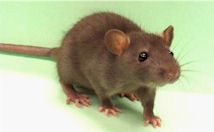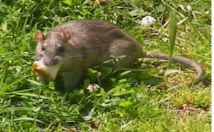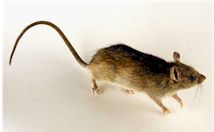| Common Name |
Brown Rat, Norway Rat, Norwegian Rat, Sewer Rat, Water Rat, German
Wanderrate |
| Scientific Name |
Rattus norvegicus |
| Size |
Length: 180 - 255 mm
Tail length: Short scaly tail, shorter than body 150-215 mm
Weight: 200-480g |
| Colour |
Grey-brown above, white to grey below with shaggy bristly fur. |
| Description |
Teeth: The brown rat has 16 teeth: 2 incisors and 6 molars in
each jaw. It has no pre-molars and, like all rodents, no canine teeth.
Ears: Small, furrier than those of the black rat. The brown rat
has very sharp hearing.
Sense of Smell: Very acute. Good for sniffing out food supplies.
Forepaws: Often used to hold food while the rat eats, although
food is carried in the mouth.
Fur: Coarser and longer than that of the sleek black ra. Protects
against cold and damp conditions.
|
| Habitat |
- Most commonly found near farms
- In garbage dumps and in sewers
|
| Lifecycle |
- Female rats are able to reproduce at approximately 3 months and
gestation (pregnancy) lasts about 21 days with each litter averaging 4 -
6. The young are weaned at between 3 - 4 weeks and reach maturity at
around 3 - 4 months of age.
- Rats do not have to wait until the original litter is weaned before being able to conceive again.
- Sexual Maturity: females, 11 weeks.
- Mating: Throughout the year.
- Gestation: 21-24 days.
- Litter Size: 6-11, depending on size of mother.
- No. of litters: Up to 5 per year
|
| Disease Transmitted |
- Can carry a plethora of organisms, responsible for diseases such
as toxoplasmosis, listeriosis, Q fever, and Hantaan fever among others.
- These diseases can be passed on to humans through contact with rat
droppings or urine, or bites from the rats or their fleas.
|
| Type of damage |
They may transmit disease, soil and destroy materials and damage
buildings |
| Prevention |
- Keep firewood stored well away from the structure. Remove debris piles.
- Seal any holes larger than 1/4 inch. Remove moisture and harbourage sources.
|
| Control |
- Good sanitation will effectively limit the number of rats that can
survive in and around the home. This involves good housekeeping, proper
storage and handling of food materials and refuse and elimination of
rodent harbourage (shelter).
- Outside dog pens must be properly maintained, to reduce potential rat problems.
- The most successful and permanent form of rat control is to "build
them out" by making their access to structures impossible. All places
where food is stored, processed or used should be rodent-proof.
- A simple, inexpensive wood-based snap trap is available in most
hardware and farm supply stores. Wire cage traps are more expensive but
somewhat more successful than snap traps. Bait traps with peanut butter
or a small piece of hot dog, bacon, or nutmeat tied securely to the
trigger.
- Rodenticides are poisons that kill rodents. They are available as
either non-anticoagulants or as anticoagulants. The non-anticoagulants
cause death either via the nervous system or via the release of calcium
into the bloodstream. Anticoagulants cause death as a result of internal
bleeding, which occurs as the animal's blood loses its clotting ability
and capillaries are destroyed.
- Some cats and dog breeds will reduce existing rat problems.
|





